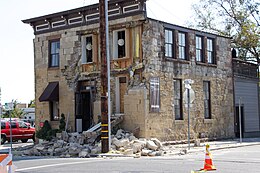2014 South Napa earthquake

Damage to the Sam Kee Laundry Building
|
|
| Date | August 24, 2014 |
|---|---|
| Origin time | 10:20:44 UTC |
| Magnitude | 6.0 Mw |
| Depth | 7 mi (11 km) |
| Epicenter | 38°13′N 122°19′W / 38.22°N 122.31°WCoordinates: 38°13′N 122°19′W / 38.22°N 122.31°W |
| Fault | West Napa Fault |
| Type | Strike-slip |
| Areas affected |
North Bay (San Francisco Bay Area) California, United States |
| Total damage | $362 million–$1 billion |
| Max. intensity | VIII (Severe) |
| Casualties | 1 killed about 200 injured |
The 2014 South Napa earthquake occurred in the North San Francisco Bay Area on August 24 at 03:20:44 Pacific Daylight Time. At 6.0 on the moment magnitude scale and with a maximum Mercalli intensity of VIII (Severe) the event was the largest in the San Francisco Bay Area since the 1989 Loma Prieta earthquake. It was located to the south of Napa and to the northwest of American Canyon on the West Napa Fault. Total damage in the southern Napa Valley and Vallejo areas was in the range of $362 million to 1 billion, with one person killed and 200 injured. Other aspects of the event included an experimental earthquake warning system that alerted seismologists several seconds before the damaging shear waves arrived, temporary changes in springs and wells, and the potential for fault creep.
The San Andreas Fault System is an active plate boundary comprising right-lateral strike-slip faults that runs nearly the length of California. This network of faults trends north-northwest in the area of the West Napa Fault, where it is 50 miles (80 km) wide from west to east. The West Napa Fault transfers slip between a group of related faults (including the Concord Fault and the Calaveras Fault) called the Contra Costa Shear Zone, which was assigned a maximum slip rate of 1mm/yr in the third Uniform California Earthquake Rupture Forecast. The authors of a separate study that focused on Global Positioning System data gave an estimated slip rate of 4±3mm/yr for the West Napa Fault.
...
Wikipedia

